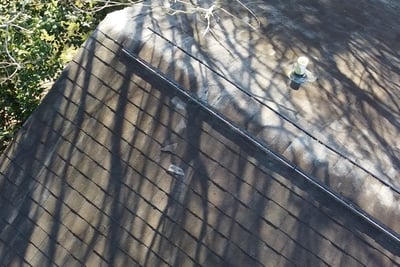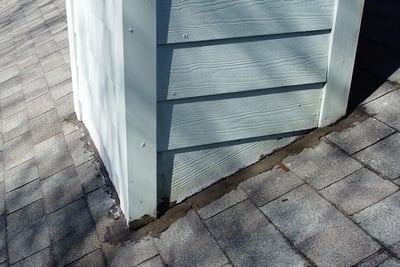When you start the process of buying a new home, the list of desirable features and potential problems can seem endless. One critical element of every home, in every climate, is the roof. The most important function of your roof is to protect your home from the elements. Rain, ice, snow, wind, temperature changes, and even sun are all blocked by your roof. Your roof also defends additional barriers like your windows, doors, walls, and siding from excess water, wind, and debris.
According to Forbes, the average cost of replacing just a roof in the U.S. is $8,000. Now imagine the additional cost and potentially catastrophic damage to your entire home that roof failure can cause, from a huge rainstorm in your living room to a slow, unseen leak within a wall. Because of this, it’s critical to make sure that the home you’re looking to purchase, or already own, has a functional, reliable roof.
Accurate knowledge of a roof’s condition can protect everyone and prevent problems, and you can access that knowledge by completing a thorough roof inspection. How much does a roof inspection cost? At Home-Probe, your roof inspection is included in every home inspection at no additional cost.
Unlike many inspectors, Home-Probe inspectors will physically walk the roof (when safe) to inspect every last inch and be sure their inspection report is detailed and thorough. A drone roof inspection is then completed to get detailed, birds-eye footage of every corner of the roof.
Here are five things every buyer should understand about the roof of a home they are considering purchasing.
1. Roof Life Expectancy
The material that a roof is made of will determine its life expectancy, or how long it will last.
| Roof Covering Material | Estimated Life Expectancy |
| 3-Tab Asphalt Shingle | 15 - 20 years |
| Architectural Asphalt Single | 20 - 30 years |
| Wood Shingle | 25 - 40 years |
| Concrete Clay/Tile | 20 - 40 years |
| Asbestos Cement | 40 - 80 years |
| Slate Tile | 40 - 80 years |
| Roll Roofing (EPDM, or ethylene propylene diene terpolymer - a durable synthetic rubber roofing membrane) |
5 - 15 years |
| Tar & Gravel | 15 - 25 years |
| Metal | 60 years |
Because of these timelines, the roof life expectancy will determine when you need to plan for replacement. The age and condition of a home’s roof can also impact your financing options and home purchase process. Home-Probe goes beyond the typical home inspection by including an estimate of the roof’s age and an estimate on its years of remaining life in your home inspection report.
If the roof on the home you are looking at is the end of its remaining life, your lender or future home insurance company may have concerns. For example, FHA loans require a remaining physical life of at least two years. If the roof does not meet that requirement, then your lender will require re-roofing or repair.
2. Roofing Layers and Composition/Materials
A roof that is covered by newer shingles sounds great, right? It may be or it may not - it depends on what is underneath that fresh surface. A now outdated roof repair method was to take a roof that was leaking or otherwise nearing the end of its life expectancy, and simply put a new roof over the top of the old roof.
Overall, this method is not recommended because the structure of a roof is designed to support a certain amount of weight. When you double that weight, then you cause an issue with the structure of the roof trusses and joists. This can cause the roof to sag, resulting in an expensive repair project. All layers will need to be removed, and the roof trusses and joists may need structural repairs to ensure a strong, safe roof. If one of the roof layers includes asbestos materials, there can be even more costs involved with the testing and abatement process.
During the roof inspection process, information will be collected on the number or layers your roof may contain, and the condition of the structure underneath these layers.
3. The Condition of Both Decking and Shingles
When most people think about the roof of a home, what they visualize is the shingle or surface material. However, your roof has many additional parts, all of which play a critical role in protecting your roof. There are eight layers to most roofs: insulation, ventilation, roof deck or sheathing, underlayment, a waterproof membrane, ridge vents, your roofing material (slate, copper, asphalt, etc.), and flashing. 
A damaged roof may be experiencing issues with one of these parts, or with all of them: Damage to one area, such as the shingles or underlayment, can lead to damage in your sheathing and even trusses and joists. Which areas are impacted, and how expensive the damage is, can be a major factor in the cost of any necessary roof repair.
Home-Probe goes beyond the typical inspection to guarantee our clients an image of the shingle from above the roof line.
4. Evidence of Water Intrusion Like Leaks
One of the most important functions of your roof is to keep water, in all forms, out of your home. Any evidence of roof water intrusion, like leaks or moisture, will be included in your home inspection report.
Home inspectors also have access to unique tools to help them find and confirm less-obvious, current water leaks. Here’s an example of two that we use:
Thermal imaging cameras detect differences in surface level temperatures, which can show evidence of water evaporation. When water evaporates, the water is cooler than the air temperature, showing a cold spot on the camera.
Moisture meters detect the level of moisture in a material, like wood or drywall. These meters can be used to confirm leaks that are otherwise invisible.
5. Penetrations: The Holes That You Want In Your Roof
There are a few holes in your roof that you will actually want and need. Penetrations such as chimneys, skylights, plumbing vents, and home and attic ventilation systems have important functional roles for a home. These serve important functions in the home: pipes carry heating, cooling, and water throughout the home, skylights provide light, and chimneys provide ventilation for cozy fireplaces. However, these ‘holes’ are also common sources of problems like water intrusion, obstructions, and attic ventilation problems.
 Penetrations should have different types of flashing around their base where they intersect the roof. These flashing systems provide a seal that keeps the elements out of your home, but unfortunately their life expectancy does not always line up with the life expectancy of the rest of your roof. The materials used in the penetrations, such as the rubber for a plumbing boot, may also have different life expectancies or be deteriorating ahead of the roof covering.
Penetrations should have different types of flashing around their base where they intersect the roof. These flashing systems provide a seal that keeps the elements out of your home, but unfortunately their life expectancy does not always line up with the life expectancy of the rest of your roof. The materials used in the penetrations, such as the rubber for a plumbing boot, may also have different life expectancies or be deteriorating ahead of the roof covering.
Your inspector should take a careful look at any penetrations and their flashing, whether by walking your roof or using a drone, and from the inside through the attic.
Protect Your Home and Your Investment with an Informed Home Inspection
Your roof protects your home in many ways, and there are almost equally as many ways that a roof can be damaged. In order to understand the true condition of a roof, an expert home inspector is critical. Not all home inspections are equal, particularly where the roof is concerned. One way you can avoid unpleasant surprises is with a comprehensive, expert inspection.
Home-Probe goes above and beyond by including a guaranteed image from above the roof. Every Home-Probe inspector carries a drone to get a full inspection and our inspectors physically walk the roof (when safe) - an important service that few other inspectors provide. The inspection report on your roof will always include details on the age and life expectancy, helping you complete your due diligence with speed and confidence.
Interested in seeing a live drone roof inspection? View on Youtube now.
A home is one of the largest purchases you will ever make, so make sure you are an informed buyer by putting our experience, expertise, and processes to work for you. Ready to schedule an inspection? Contact Home-Probe today.